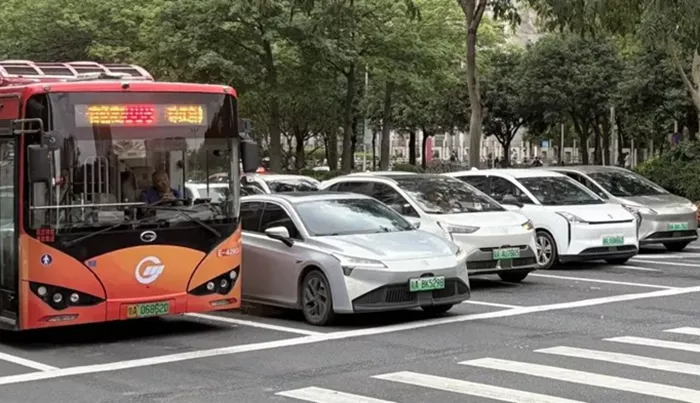“I drive an electric vehicle because I am poor,” says Lu Yunfeng, a private hire driver at a charging station on the outskirts of Guangzhou, China.
Nearby, Sun Jingguo shares a similar sentiment: “The cost of driving a petrol car is too expensive. I save money driving an electric vehicle,” he says, standing by his white Beijing U7 model.
Such remarks may seem rare in many countries, where electric vehicles (EVs) are often seen as luxury items. But in China, where nearly half of all cars sold last year were electric, these comments reflect the nation’s shift towards sustainability and affordability.
A Decade Ahead of the World
Once a country dominated by bicycles, China has transformed into the world leader in electric vehicles. For Guangzhou’s 18 million residents, the buzz of rush hour traffic has been replaced by the hum of electric cars.
“When it comes to EVs, China is 10 years ahead and 10 times better than any other country,” says Michael Dunne, an auto sector analyst.
BYD, a Chinese carmaker, now leads the global EV market, having surpassed US competitor Tesla earlier this year. The company’s success is fueled by China’s massive domestic market, boasting over 1.4 billion people, and its ambition to expand globally. Alongside BYD, several other Chinese startups are creating affordable EVs for the mass market.
The Strategy Behind China’s EV Success
The roots of China’s dominance in electric vehicles can be traced back to 2007, when Wan Gang, a German-trained engineer, became China’s Minister of Trade and Science. At that time, Chinese brands struggled to compete with European, American, and Japanese carmakers, who had a significant lead in producing petrol and diesel vehicles.
Recognizing this, Wan decided to push China into the electric vehicle race, capitalizing on the nation’s vast resources, skilled labor force, and supplier ecosystem.
The Master Plan: Government Support and Investment
China’s government had already included electric vehicles in its five-year economic plans by 2001, but it wasn’t until the 2010s that the country began providing substantial subsidies to the sector. The government’s ability to marshal resources over the long term allowed China to create a thriving EV industry. According to the Center for Strategic and International Studies (CSIS), Beijing has spent approximately $231 billion on the EV sector between 2009 and 2023.
This state-led investment has spurred rapid growth, including encouraging firms like BYD to pivot from smartphone battery production to electric vehicle manufacturing. Meanwhile, battery supplier CATL, based in Ningde, has become a global leader, supplying batteries to companies like Tesla, Volkswagen, and Ford.
In addition, China’s public charging network has become the largest in the world, with stations conveniently placed in major cities, making EV charging more accessible.
“State Capitalism” and Competitive Innovation
Some observers describe China’s approach as “state capitalism,” while others, especially Western countries, label it unfair competition. Nevertheless, Chinese EV executives argue that all companies, both domestic and foreign, have access to the same resources.
Brian Gu, president of XPeng, one of China’s leading EV makers, explains: “The Chinese government is doing the same thing you see in Europe and in the US—providing policy support, consumer encouragement, and infrastructure. But I think China has done it consistently in a way that fosters the most competitive landscape.”
XPeng, a start-up that is already among the world’s top 10 EV producers, is just one example of China’s innovation-driven market. The company offers cars with cutting-edge technology, including self-driving capabilities and advanced voice activation systems, all for around $20,000—appealing to China’s younger generation.
Affordability and Government Incentives
For many Chinese consumers, the affordability of EVs is a key factor. Government subsidies for trading in older petrol cars and tax exemptions make electric vehicles more financially attractive. For instance, Lu Yunfeng switched to an EV two years ago, saving on fuel costs and receiving a free registration plate, typically a costly expense in Chinese cities.
Other cities, like Shanghai, have introduced automated battery swapping stations, allowing drivers to replace their EVs’ batteries in under three minutes, significantly reducing charging time.
Global Implications and Market Expansion
While China’s heavy subsidies have raised concerns in the West, with countries like the US, Canada, and the European Union imposing taxes on Chinese EV imports, China remains confident about its future. The UK, for example, has not imposed similar taxes, creating an opportunity for Chinese companies like XPeng and BYD to expand in Europe.
The United Nations views the transition to electric vehicles as crucial to mitigating climate change, and Western governments may need to partner with China in the future to support global EV adoption.
“The Chinese are thinking about a future where they manufacture just about every car for the world,” says Michael Dunne. “It’s a new era, and the Chinese are feeling very confident about their prospects.”
National Security Concerns
However, not all are optimistic about relying on Chinese technology. Former MI6 head Sir Richard Dearlove has raised alarms about the potential for Chinese-made EVs to be used for surveillance, calling them “computers on wheels” that could be controlled remotely.
Despite such concerns, BYD’s executive vice-president Stella Li dismisses these fears, stating, “We pay for a very high standard of data security. In fact, we do it 10 times better than our competition.”
For ordinary consumers like Sun Jingguo in Guangzhou, the advantages of Chinese EVs are clear. “I think the world should thank China for bringing this technology to the world,” he says with a smile. “I do.”

